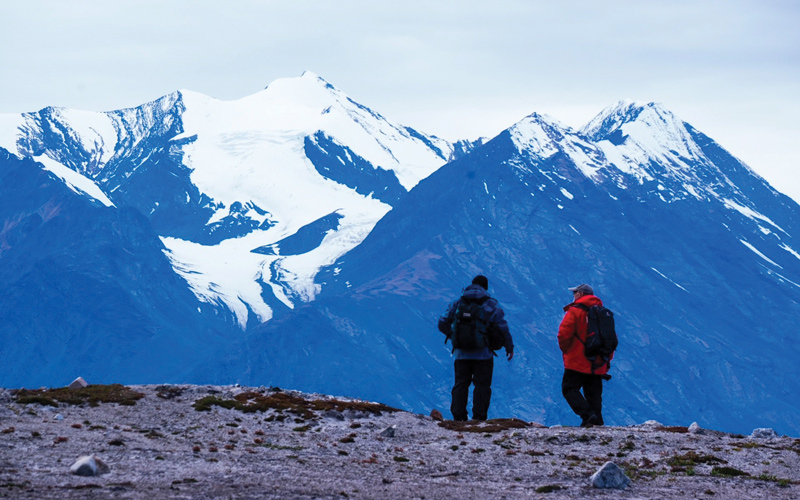Northeast Greenland and Svalbard
My travels have taken me to over 100 countries, yet until recently,

I had not penetrated either polar region. I finally traveled to the world’s northernmost permanent settlement: Longyearbyen, Svalbard, at 78 degrees North Latitude by booking a week-long, high-latitude adventure with Poseidon Expeditions. This is the embarkation point for most high Arctic polar tríps with Poseidon. In August 2022, I joined a two-week expedition from Svalbard to eastern Greenland, following in the footsteps of Norwegian explorer Roald Amundsen.
The Arctic contains some of the last untouched wilderness and the vastest open spaces on our planet. It’s defined by colossal glaciers that shimmer in the summer’s midnight sun, lofty icebergs, picturesque fjords and mountains in polychromatic stripes. In Svalbard, polar bears outnumber humans.
Poseidon Adventure
Since 1999, Poseidon Expeditions has forged routes to the Arctic, North Pole and Antarctica. Its voyages follow the routes of such intrepid and enigmatic explorers as Amundsen, Peary, Scott and Shackleford — with onboard education and traverses of frigid, ice-blue waters in zodiacs and kayaks.
Our voyage began in Longyearbyen, following a flight with Norwegian Airlines from Oslo. Located about halfway between Norway’s capital city and the North Pole, the town of a little more than 3,000 people is on the island of Spitsbergen in the Svalbard archipelago.
Longyearbyen has a handful of lodging options, restaurants and shops. A worthy destination is the Svalbard Museum, which chronicles the region’s unique history.
Afoot in Greenland
“When you’ve seen the world, there’s always Greenland!” … or so I’ve heard said by intrepid travelers. The world’s largest island (after the continent of Australia), it is equal in size to France and Spain combined, yet it is also the world’s most sparsely populated major island.
It took two days at sea — attending lectures but otherwise relaxing and preparing — before we arrived at Northeast Greenland National Park. We disembarked by zodiac craft to visit the Kong Oscar and Kejser Franz Josef fjord systems. Franz Josef, in particular, is known for its multi-layered mountains with rust-red, polychromatic stripes.
This biosphere reserve was established in 1974. It has no permanent human population, although around 50 scientists remain over the winter season. Most of the terrain consists of icecap, but in the summer months, as the snow melts, arctic flowers bloom over rugged landscapes.
Flora and fauna are fully protected. The park is home to 10,000 to 15,000 muskoxen, polar bears, Arctic hares and elusive Arctic foxes. Marine mammals include seals, walruses and multiple whale species, including beluga, narwhal, humpback, blue and sperm whales.
On zodiac landings, we hiked into the world’s largest protected area. Mountains that were ice-covered even in summer, fjords, icebergs and glaciers were highlights. We were lucky: The unpredictability of weather and wildlife sightings allows for no landing guarantees.
Recalling Amundsen
Norway’s Roald Amundsen defied the elements and made his way to the extremes of both poles. In 1926, Amundsen and his team of 15 men became the first party to reach the North Pole, not by ship, but by air. Two years later, on another air mission, Amundsen disappeared. His remains were never found.
There is a statue of the dauntless explorer back in Svalbard, at Ny-Alesund, a former coal-mining village reborn as the world’s northernmost scientific research station. Now it’s home to dozens of scientists from around the world (even including China) who conduct Arctic research.
A ‘Spirited’ voyage
Built in 1991, its guest cabins and public spaces renovated in 2017, the six-deck Sea Spirit houses up to 114 passengers and 72 crew. The stylish vessel is a warming solace compared to the barren wilderness, icebergs and glaciers of the outdoor Arctic.
Cabins range in size from modest to the 463-square-foot owner’s suite.Guests spend a couple of hours each day in the spacious Oceanus Lounge attending lectures and recaps of the day’s discoveries. Also aboard are a club lounge, bar, gym, library, hot tub, and outside viewing decks. Hospitality includes “welcome home” treats — warm towels and hot tea — to guests returning to the ship from zodiac excursions.
The expansive restaurant on the main deck offers open seating. Gourmet dinners are elaborate affairs; they begin with starters like grilled duck salad, followed by such main courses as veal marsala, chicken cordon bleu or seared ahi tuna. Desserts are delectable and there are vegetarian and Indian meal options. There is also a pre-meal happy hour with hors d’oeuvres and one formal captain’s dinner, where you’ll want to dress up.
Polar Professionals
The stellar expedition team of international polar experts is led by Ida Olsson. Poseidon’s Polar team undergoes a rigorous training program to ensure safety and provide education on the regions. Geologists, kayak masters, professional photographers, hiking guides, historians and ornithologists make this odyssey extraordinary. Dutchman Ab Steenvoorden, a seasoned seafarer-ornithologist, kept us entertained and flaunted uncanny expertise for finding wildlife.
A few details
All flights to Svalbard go via mainland Norway. There are no direct flights from anywhere in the world to Svalbard. SAS (Scandinavian Airlines) and Norwegian Airlines fly from Oslo and Tromsø to the town of Longyearbyen.
The Arctic fascinates all those who visit, and no two voyages are the same. Poseidon’s small ship advantage allows for intimate encounters on and off the vessel, with two or three rapid daily landings.
Every expedition is unique, with shifting ice and animal sightings. As with any expedition, patience, tolerance and understanding are the keys to a successful journey.




